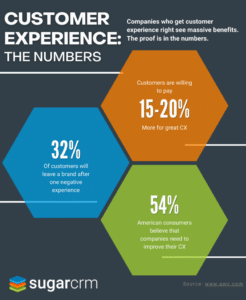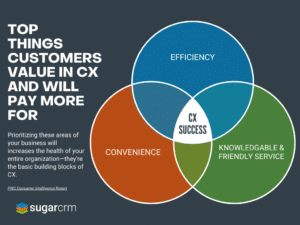Customer Experience: Focusing on the Basics
Is Customer Experience really that Important?
Yes.
 Companies who get customer experience right see massive benefits. Here’s what PWC’s survey of 15,000 consumers revealed:
Companies who get customer experience right see massive benefits. Here’s what PWC’s survey of 15,000 consumers revealed:
- Customers are willing to spend 10-20% more for a great customer experience.
- Negative experiences drive customers away. 32% of customers will abandon a brand after one bad experience and 59% leaving after multiple bad experiences
- 54% of US consumers say customer experience at most companies needs improvement.
When you provide a great customer experience (CX), customers spend more, refer more, and stay longer. In a world where managing customer churn is of the utmost importance, the value of a great CX strategy cannot be understated. CX is no longer optional, no longer something that you can ignore because your customers will walk with their business to a competitor and according to the data, in 32% of those cases, you only have one chance to get it right.
I like to think of CX as a way to strengthen your organizational immune system.
A solid CX strategy and framework also differentiates your business from competitors and has a ripple effect of creating harmony within your organization. Customers feel heard when they are engaged and employees receive a roadmap of what those customers are trying to accomplish, how they want to do it, and where they encounter friction. Great CX provides a seamless view of the customer and clarity on how the employee can best aid them to accomplish their goals. Employees are empowered with the tools not only to do their job well but to reap the satisfaction and praise of the customer. This success increases employee satisfaction and, overall, employee retention.
Whether you look at it from the financial lens or human perspective—customer experience wins every time.
How can I Improve Customer Experience in my Business?
Making a massive shift in business can seem daunting, but there are multiple layers to improving CX in your business. It’s essential to begin with the fundamentals of CX and master them before you transition to any of the bells and whistles. Additions may seem attractive and enticing, but they are not the end goal—in fact, good CX doesn’t have an end goal because it should evolve as your customer evolves. CX, while helping to reinforce your bottom line, is more about the customer rather than the business because, without your customers, you would not exist.
If you’re starting at the basics, what are they? Again, we can lean on research to tell us. More than 80% of US consumers surveyed by PWC state that efficiency, convenience, and knowledgeable/friendly service are the most important components of a positive customer experience. Prioritize improvements in those areas of your business, and you strengthen the entire organization.

Each point, efficiency, convenience, or knowledgeable/friendly service is worth exploring as a standalone but it’s important to understand the why behind these concepts. Put yourself in the position of the customer; what matters to you during a buying experience? You want the process to be seamless, easy, and in the advent of a problem, you want to know that you can find the help that you need.
Where do you begin? Step back into the role of your business, look at these fundamentals. Is your buying process efficient? Are your offerings convenient? When your customers have a problem are you informed and friendly? Is your team helpful?
While you may not have the answers to these questions, it’s important to gauge the answers in the areas they are most relevant. If you find answers that say, I don’t know or we aren’t sure, start your plan there to optimize that one aspect and then move onto the next.
Build the Big Picture
To gauge what you need to do with customer experience, it’s important to start at the source—the customer. You need to understand what they want plus their key issues or pain points and how they address those issues and what they look for in a vendor relationship. It is with these items that you can move forward and improve your own CX.
1) Identifying the Customer
To get started, you’ll need to define your buyer. It’s important to develop both your ideal customer profile (ICP) and the buyer personas that you intend to sell to within these companies defined in the ICP. As a business, you most likely know what your ideal customer is, but perhaps buyer personas have not seen much traction outside of the sales or marketing team. While each of these teams has additional uses for the buyer persona, understanding those personas as a company can accelerate your sales and service strategies as well as increase your CX.
Start by understanding the needs and wants of your persona in relation to your business and frame how they buy and their habits. By doing this, you create a roadmap from the buyer’s perspective and provide a framework for discussing improvements in a customer-specific context. It’s important to note here that businesses often have multiple buyer personas that can vary especially when that business offers multiple products. Be careful and don’t boil the ocean yet—pick one buyer persona that represents the largest section of your business as suggested by your revenue. If you aren’t sure where to start with creating a buyer persona, we have a simple guide and template that you can use to help you get started here. Over time, you will begin to hone your personas, but for this exercise, it’s probably going to take you roughly 4-6 hours to complete.
2) Conduct Competitive Research
 Once you’ve defined your customer and their needs, it’s time to impersonate them—secret shopper style. You’re going to evaluate a similar product market from the role of the customer, meaning you’re going to search to find the answers that your customer would be searching for. Pick a product or service that is similar to your organization’s rather than evaluating your competitors. This is a key point of understanding and could take a few days to a few weeks to complete but the amount of time you invest in this step is wholly dependent on how deep you decide to go.
Once you’ve defined your customer and their needs, it’s time to impersonate them—secret shopper style. You’re going to evaluate a similar product market from the role of the customer, meaning you’re going to search to find the answers that your customer would be searching for. Pick a product or service that is similar to your organization’s rather than evaluating your competitors. This is a key point of understanding and could take a few days to a few weeks to complete but the amount of time you invest in this step is wholly dependent on how deep you decide to go.
To start with this evaluation, begin online with a simple search. Begin with the information you learn paying special attention to how you learn about creating a solution. What resources are you using? What information are you finding helpful? What are you finding frustrating about the process?
Throughout this process, you will engage with prospective vendors by signing up for email lists, filling out gated forms for content to evaluate, and engaging with brands via social. Since these are most likely your competitors, it can be helpful to mask your email with a disposable one but don’t delete anything—you’re going to need it later.
Record and document this process including any logins you create plus screenshots. It’s helpful to organize this information into a presentation, cutting down on the work for later when you (most likely) will present it to team members. This also creates a record of interactions and notes regarding your step-by-step process to evaluate against your own. Be sure to also include information on how some of these interactions made you feel. With 95% of decisions made in the subconscious, emotions are important to the buyer’s journey—don’t discount them.
After you feel as though you’ve gleaned enough information from other vendors, it’s time to create a shortlist because, undoubtedly, there will be some areas where you found information that was not helpful. As you engage with your shortlist of vendors, take note of what information they ask for and when. Map out the touchpoints, where you encounter friction, and how the experience relates back to your goals and feelings as a buyer. Take note of who you meet with and when, how they follow up after your conversation, their level of friendliness, and how accurately and efficiently they address your questions and concerns.
For each vendor, map out a journey. Additionally, you should map out your own buyer’s journey for your organization. It’s important to contrast and compare what you felt was a successful interaction versus a negative one. You may like different aspects from different vendors but the main goal here is to benchmark your company’s CX versus your competitors. This analysis should provide a perspective of where your company is behind on CX and the problem areas to address first. It’s important to note, that you want to focus on defining the problems, not the solutions at this stage.
3) Explore Improvements and Obtain Internal Feedback
 With all this information, it’s time to bring additional perspectives into the conversation. Brainstorm solutions with people from around your business or peers in the industry. Look at competitors, see what they are doing, and home in on the problem areas with additional points of view on avenues to solve the problem, backed with examples. During this step, it’s less about the how, and more on the “so what”.
With all this information, it’s time to bring additional perspectives into the conversation. Brainstorm solutions with people from around your business or peers in the industry. Look at competitors, see what they are doing, and home in on the problem areas with additional points of view on avenues to solve the problem, backed with examples. During this step, it’s less about the how, and more on the “so what”.
Expand your pool of thought leaders, bringing together a cross-functional team including departments such as sales, IT, and marketing to the conversation. Present the problems using the journey map and competitive research asking for possible solutions as well as an understanding of the business impact and value of addressing each problem area. Rank and prioritize each problem as an exercise to establish consensus and focus. Find where there are quick wins, where you need to invest in additional technology, and what issues will require larger change management and a more measured approach. There are multiple possibilities here, but let’s look at some examples:
Quick Wins
-
- Automation of email routing to the appropriate team for resolution
- Centralization of customer purchases, communications, entitlements, and service requests to create a journey aware view of the customer
- Automated escalation, service level attainment, routing, and the response of customer requests
- Measure Net Promoter Score (NPS) across critical customer interactions such as service, post-sale engagement, etc.
- Collaboration with your customers via a self-service portal
- Understanding of SLA metrics and improvements
Additional Technology Investments
-
- Implementation of marketing automation to enhance personalization
- Usage of artificial intelligence bots to aid in the buyer’s journey across your website
- Mobile improvements to both your team and website plus additional capability that provides customers flexibility
- Creation of a self-service portal for customers to find answers to their questions
Long Term CX Investments
-
- Buyer journey optimization across departments
- NPS improvements based on customer interactions
- Define customer SLAs and communication parameters
- Communications between teams and leadership regarding priorities
- Customer retention strategy and maintenance via sales and customer service
Create a program review cadence with the team and develop accountability across the organization to improve CX consistently as an overarching theme. The above suggestions are only a small part of what you might encounter during your collaboration with the larger team but it’s important to segment them into areas where they are best suited for increasing your organization’s CX.
Bringing it Together: Start Small for Big Wins
Creating a CX strategy focused on the basic elements of what customers value— efficiency, convenience, or knowledgeable/friendly service—is the first step to creating a cohesive experience for your customers. As your strategy expands, developing review cadences, accountability within your organization, and feedback programs are also great propellants to climbing to the next level with customers. But remember, walk before you run. Customers want consistency; prioritize the basics and keep them as the standard for what your organization provides and improve from there.
Small steps and consistency within a CX strategy are what make it successful, and this is only a small part of what you will want to optimize and improve throughout your organization. Start with the quick wins and continually target areas of your organization where you can increase your CX on an individual level. Through providing a continually positive experience to your customers, you’ll begin to unlock the fidelity needed throughout your organization to have a high-definition view of what customers want. After which you can unlock a high-definition customer experience that further hones your strategy and provides a detailed view of your customers and, ultimately, unlock the revenue potential only available with a successful CX strategy.




